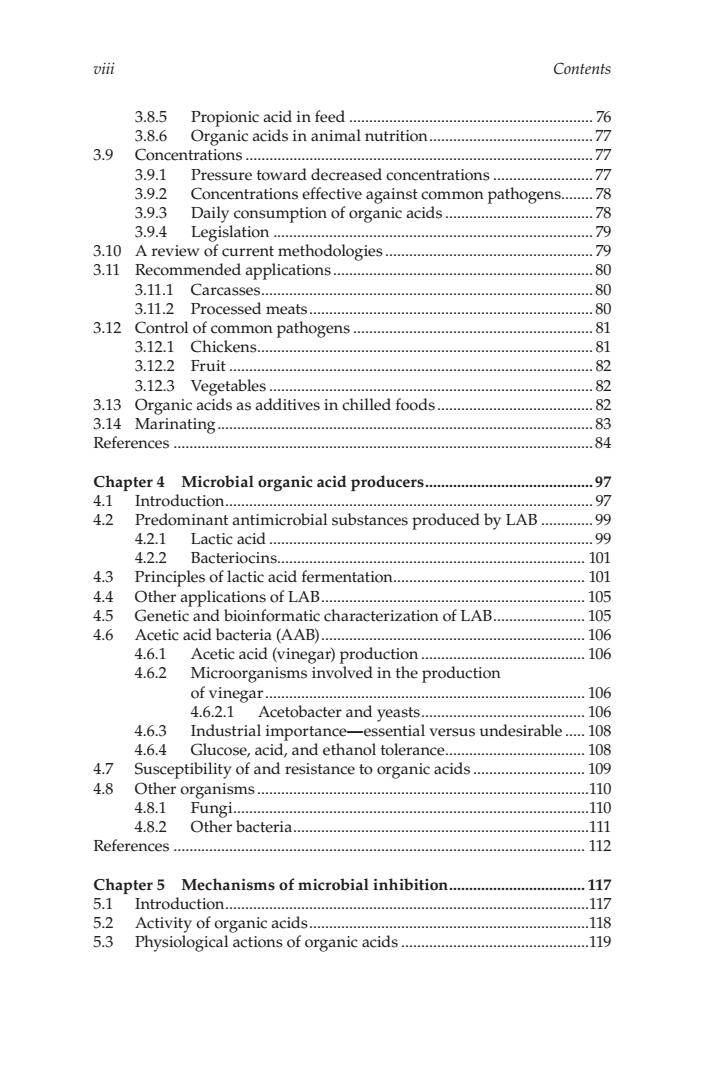
i Contents 385 Propionic acid in feed 76 Organic acids in animal nutrition 3.9 3.9.1 Pressure toward decreased concentrations .77 3.9.2 Concentrations effective against common pathogens........78 3.9.3 Daily consumption of organic acids.. .78 3.9.4 Legislation. .79 3.10 A review of current methodologies 79 3.11 Recommended applications.. 80 3111 Carcas 3.11.2 P 3.12 Control of common pathogens. 08 3.12.1 Chickens.... 3.12.2 Fruit .. .82 3.12.3 Vegetables. 82 3.13 Organic acids as additives in chilled foods 82 3.14 Marinating. 83 References 84 Chapter4 Microbial organic acid producers 97 Introduction.. .91 42 Predominant antimicrobial substances produced by LAB .99 4.2.1 Lactic acid. .99 4.2.2 Bacteriocins. 101 43 Principles of lactic acid fermentation. 101 44 Other applications of LAB. 10 4.5 Geneti atic characterization of LAB. 105 4.6 tic acid bacter 106 4.6 106 4.6.2 Microorganisms involved in the production of vinegar... 106 4.6.2.1 Acetobacter and yeasts. .106 463 Industrial importance-essential versus undesirable.....108 4.6.4 Glucose,acid,and ethanol tolerance.. .108 4.7 Susceptibility of and resistance to organic acids 10g 4.8 Othe organi 110 4.8.1 4.8.2 ther bacteria References. 112 Chapter 5 Mechanisms of microbial inhibition .117 51 Introduction.. 117 5.2 Activity of organic acids.. 118 5.3 Physiological actions of organic acids .11g
viii Contents 3.8.5 Propionic acid in feed ............................................................. 76 3.8.6 Organic acids in animal nutrition......................................... 77 3.9 Concentrations ....................................................................................... 77 3.9.1 Pressure toward decreased concentrations ......................... 77 3.9.2 Concentrations effective against common pathogens........ 78 3.9.3 Daily consumption of organic acids ..................................... 78 3.9.4 Legislation ................................................................................ 79 3.10 A review of current methodologies .................................................... 79 3.11 Recommended applications ................................................................. 80 3.11.1 Carcasses................................................................................... 80 3.11.2 Processed meats....................................................................... 80 3.12 Control of common pathogens ............................................................ 81 3.12.1 Chickens.................................................................................... 81 3.12.2 Fruit ........................................................................................... 82 3.12.3 Vegetables ................................................................................. 82 3.13 Organic acids as additives in chilled foods ....................................... 82 3.14 Marinating.............................................................................................. 83 References ......................................................................................................... 84 Chapter Microbial organic acid producers 4 .......................................... 97 4.1 Introduction............................................................................................ 97 4.2 Predominant antimicrobial substances produced by LAB ............. 99 4.2.1 Lactic acid ................................................................................. 99 4.2.2 Bacteriocins............................................................................. 101 4.3 Principles of lactic acid fermentation................................................ 101 4.4 Other applications of LAB.................................................................. 105 4.5 Genetic and bioinformatic characterization of LAB....................... 105 4.6 Acetic acid bacteria (AAB).................................................................. 106 4.6.1 Acetic acid (vinegar) production ......................................... 106 4.6.2 Microorganisms involved in the production of vinegar................................................................................ 106 4.6.2.1 Acetobacter and yeasts......................................... 106 4.6.3 Industrial importance—essential versus undesirable ..... 108 4.6.4 Glucose, acid, and ethanol tolerance................................... 108 4.7 Susceptibility of and resistance to organic acids ............................ 109 4.8 Other organisms ...................................................................................110 4.8.1 Fungi.........................................................................................110 4.8.2 Other bacteria..........................................................................111 References ....................................................................................................... 112 Chapter Mechanisms of microbial inhibition 5 .................................. 117 5.1 Introduction...........................................................................................117 5.2 Activity of organic acids......................................................................118 5.3 Physiological actions of organic acids ...............................................119
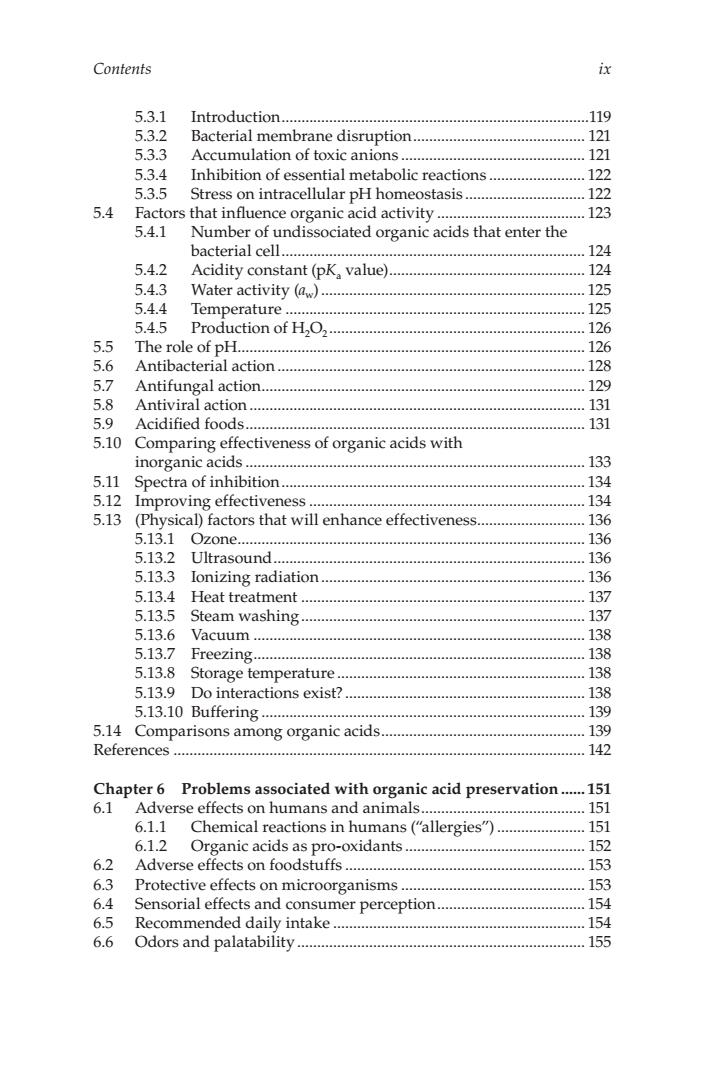
Contents 521 Introduction. 119 537 Bacterial m 121 5.33 mal membra toxic anions 53.4 Inhibition of esse ntial metabolic reactions. 53.5 Stress on intracellular pH homeostasis... 122 5.4 Factors that influence organic acid activity... 123 5.4.1 Number of undissociated organic acids that enter the bacterial cell...... 124 5.4.2 Acidity constant (pK value)124 543 Water activity (a). 125 544 Temperature 125 545 Production of H,O, 55 The role of pH... 126 5.6 Antibacterial action. akm 129 13 Acidified foods 31 Comparing effectiveness of organic acids with inorganic acids 133 5.11 Spectra of inhibition...... 1 5.12 Improving effectiveness... 134 5.13 (Physical)factors that will enhance effectiveness......................136 5.13.1 Ozone..... 136 5.13.2 Ultrasound. 5.13.3 Ionizing radiation 5.134 Heat treatment 137 5135 washing. 5136 138 5137 Freezi 138 rage ter mperature Do interactions exist? 5.13.10 Buffering........ 5.14 Comparisons among organic acids 139 References 142 Chapter 6 Problems associated with organic acid preservation......151 6.1 Adverse effects on humans and animals.. 151 611 Chemical reactions in humans("allergies"). 151 6.1.2 Organic acids as pro-oxidants 152 6.2 Adverse effects on foodstuffs 153 Protectiv microorganisms 153 nsorial eff 154 R ended daily intakener perception 154 Odors and palatability.... 155
Contents ix 5.3.1 Introduction.............................................................................119 5.3.2 Bacterial membrane disruption........................................... 121 5.3.3 Accumulation of toxic anions .............................................. 121 5.3.4 Inhibition of essential metabolic reactions ........................ 122 5.3.5 Stress on intracellular pH homeostasis .............................. 122 5.4 Factors that influence organic acid activity ..................................... 123 5.4.1 Number of undissociated organic acids that enter the bacterial cell............................................................................ 124 5.4.2 Acidity constant (pKa value)................................................. 124 5.4.3 Water activity (aw).................................................................. 125 5.4.4 Temperature ........................................................................... 125 5.4.5 Production of H2O2 ................................................................ 126 5.5 The role of pH....................................................................................... 126 5.6 Antibacterial action ............................................................................. 128 5.7 Antifungal action................................................................................. 129 5.8 Antiviral action.................................................................................... 131 5.9 Acidified foods..................................................................................... 131 5.10 Comparing effectiveness of organic acids with inorganic acids ..................................................................................... 133 5.11 Spectra of inhibition............................................................................ 134 5.12 Improving effectiveness ..................................................................... 134 5.13 (Physical) factors that will enhance effectiveness........................... 136 5.13.1 Ozone....................................................................................... 136 5.13.2 Ultrasound.............................................................................. 136 5.13.3 Ionizing radiation.................................................................. 136 5.13.4 Heat treatment ....................................................................... 137 5.13.5 Steam washing....................................................................... 137 5.13.6 Vacuum ................................................................................... 138 5.13.7 Freezing................................................................................... 138 5.13.8 Storage temperature .............................................................. 138 5.13.9 Do interactions exist? ............................................................ 138 5.13.10 Buffering ................................................................................. 139 5.14 Comparisons among organic acids................................................... 139 References ....................................................................................................... 142 Chapter Problems associated with organic acid preservation 6 ...... 151 6.1 Adverse effects on humans and animals......................................... 151 6.1.1 Chemical reactions in humans (“allergies”)...................... 151 6.1.2 Organic acids as pro-oxidants ............................................. 152 6.2 Adverse effects on foodstuffs ............................................................ 153 6.3 Protective effects on microorganisms .............................................. 153 6.4 Sensorial effects and consumer perception..................................... 154 6.5 Recommended daily intake ............................................................... 154 6.6 Odors and palatability ........................................................................ 155
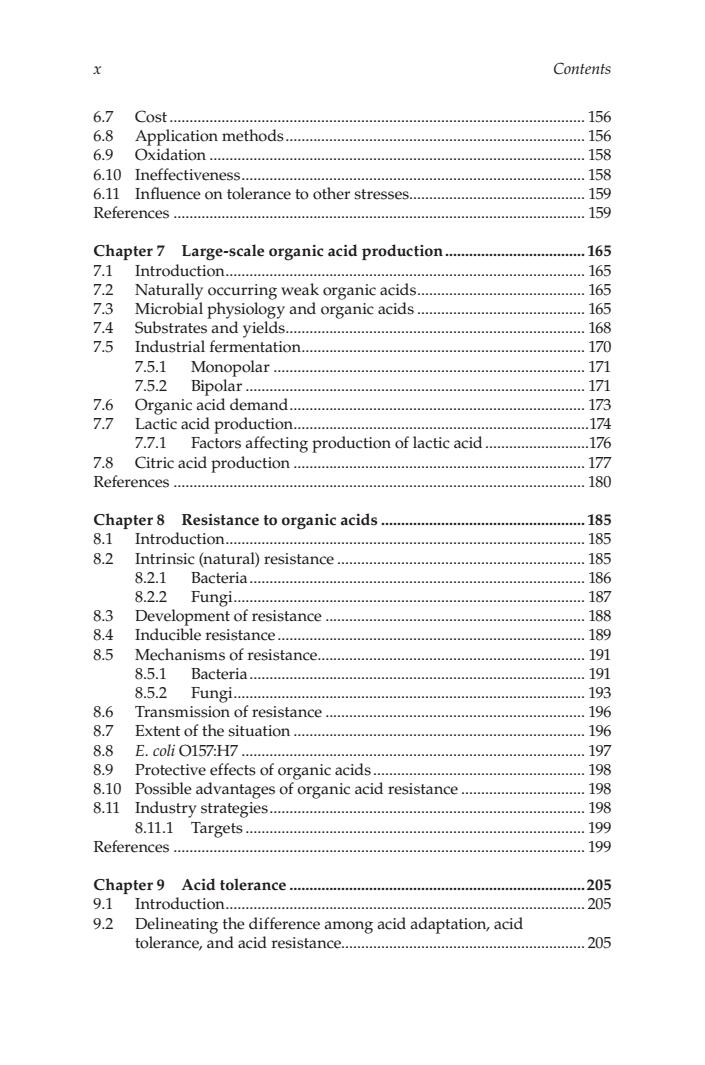
x Contents 6> Cost 156 15 Oxidation. 15 6.10 Ineffectiveness 6.11 Influence on tolerance to other stresses 159 References...... 159 Chapter 7 Large-scale organic acid production.. .165 7.1 Introduction.... 165 72 Naturally occurring weak organic acids... 16 7.3 Microbial physiology and organic acids. 16 7.4 nd vields 16Q 7.5 Industrial fern entation. 170 opolar Organic acid demand Lactic acid production... .174 7.7.1 Factors affecting production of lactic acid. .176 7.8 Citric acid production... .177 References........ .180 Chapter 8 Resistance to organic acids. .185 81 Introduction... 185 8.2 Intrinsic(natural)resistance 185 g21 186 822 Fun 187 4444944445444449中44444444949 1 8.4 Inducibl er of resistance 189 Mechanisms of resistance....... 1 8.5. Bacteria.... 191 8.5.2 Fungi. 193 8.6 Transmission of resistance. 196 8.7 Extent of the situation... 196 8.8 E.coli O157:H7. 197 8.9 Protective effects of organic acids. 198 8.10 Possible advantages of organic acid resistance 198 8.11 Industry strategies 198 8.11.1 19g 199 Chapter9 Acid tolerance 205 Introduction 205 Delineating the difference among acid adaptation,acid tolerance,and acid resistance... .205
x Contents 6.7 Cost........................................................................................................ 156 6.8 Application methods........................................................................... 156 6.9 Oxidation .............................................................................................. 158 6.10 Ineffectiveness...................................................................................... 158 6.11 Influence on tolerance to other stresses............................................ 159 References ....................................................................................................... 159 Chapter Large-scale organic acid production 7 ................................... 165 7.1 Introduction.......................................................................................... 165 7.2 Naturally occurring weak organic acids.......................................... 165 7.3 Microbial physiology and organic acids .......................................... 165 7.4 Substrates and yields........................................................................... 168 7.5 Industrial fermentation....................................................................... 170 7.5.1 Monopolar .............................................................................. 171 7.5.2 Bipolar..................................................................................... 171 7.6 Organic acid demand.......................................................................... 173 7.7 Lactic acid production..........................................................................174 7.7.1 Factors affecting production of lactic acid..........................176 7.8 Citric acid production ......................................................................... 177 References ....................................................................................................... 180 Chapter Resistance to organic acids 8 ................................................... 185 8.1 Introduction.......................................................................................... 185 8.2 Intrinsic (natural) resistance .............................................................. 185 8.2.1 Bacteria.................................................................................... 186 8.2.2 Fungi........................................................................................ 187 8.3 Development of resistance ................................................................. 188 8.4 Inducible resistance ............................................................................. 189 8.5 Mechanisms of resistance................................................................... 191 8.5.1 Bacteria.................................................................................... 191 8.5.2 Fungi........................................................................................ 193 8.6 Transmission of resistance ................................................................. 196 8.7 Extent of the situation ......................................................................... 196 8.8 E. coli O157:H7 ...................................................................................... 197 8.9 Protective effects of organic acids ..................................................... 198 8.10 Possible advantages of organic acid resistance ............................... 198 8.11 Industry strategies............................................................................... 198 8.11.1 Targets ..................................................................................... 199 References ....................................................................................................... 199 Chapter Acid tolerance 9 ..........................................................................205 9.1 Introduction.......................................................................................... 205 9.2 Delineating the difference among acid adaptation, acid tolerance, and acid resistance............................................................. 205
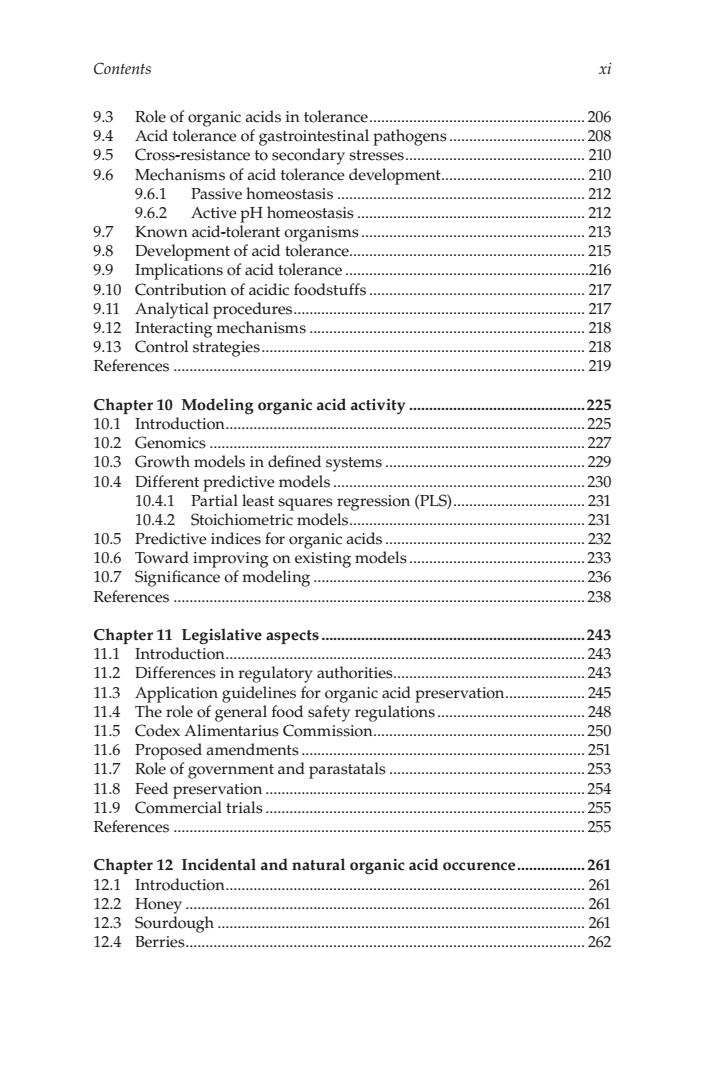
Contents 93 Role of organic acids in tolera 20e 94 Acid tole 9.5 stinal pathogens 208 ondary stres 2 9.6 chanisms of acid tolerance development. 210 9.0.1 Passive homeostasis 213 9.6.2 Active pH homeostasis 212 Known acid-tolerant organisms 213 Development of acid tolerance. 215 9.9 Implications of acid tolerance. 216 9.10 Contribution of acidic foodstuffs 21 9.11 Analytical procedures. 217 9.12 Interacting mechanisms.. 21只 9.13 Control strategies. )18 References 219 Introduction. 225 22> 10.3 Growth models in defined systems. 9 10.4 Different predictive models.... 20 10.4.1 Partial least squares regression(PLS).. .231 10.4.2 Stoichiometric models.. .231 10.5 Predictive indices for organic acids.. 232 10.6 Toward improving on existing models 233 10.7 Significance of modeling.... .236 References 238 Chapter 11 Legislative aspects 43 111 Introduction 243 11.2 Differences 24 ation guidelines for organic acid preservation. 11.4 The role of general food safety regulations.... 11.5 Codex Alimentarius Commission. 250 116 Proposed amendments.... 25 11.7 Role of government and parastatals............ ,.253 11.8 Feed preservation.. .254 11.9 Commercial trials .255 References」 .255 Chapter 12 Incidental and natural organic acid occurence .261 121 ntroduction 261 Honey 261 ugh 261 Berries.. 262
Contents xi 9.3 Role of organic acids in tolerance...................................................... 206 9.4 Acid tolerance of gastrointestinal pathogens .................................. 208 9.5 Cross-resistance to secondary stresses............................................. 210 9.6 Mechanisms of acid tolerance development.................................... 210 9.6.1 Passive homeostasis .............................................................. 212 9.6.2 Active pH homeostasis ......................................................... 212 9.7 Known acid-tolerant organisms ........................................................ 213 9.8 Development of acid tolerance........................................................... 215 9.9 Implications of acid tolerance .............................................................216 9.10 Contribution of acidic foodstuffs ...................................................... 217 9.11 Analytical procedures......................................................................... 217 9.12 Interacting mechanisms ..................................................................... 218 9.13 Control strategies................................................................................. 218 References ....................................................................................................... 219 Chapter Modeling organic acid activity 10 ............................................225 10.1 Introduction.......................................................................................... 225 10.2 Genomics .............................................................................................. 227 10.3 Growth models in defined systems .................................................. 229 10.4 Different predictive models ............................................................... 230 10.4.1 Partial least squares regression (PLS)................................. 231 10.4.2 Stoichiometric models........................................................... 231 10.5 Predictive indices for organic acids .................................................. 232 10.6 Toward improving on existing models ............................................ 233 10.7 Significance of modeling .................................................................... 236 References ....................................................................................................... 238 Chapter Legislative aspects 11 ..................................................................243 11.1 Introduction.......................................................................................... 243 11.2 Differences in regulatory authorities................................................ 243 11.3 Application guidelines for organic acid preservation.................... 245 11.4 The role of general food safety regulations ..................................... 248 11.5 Codex Alimentarius Commission..................................................... 250 11.6 Proposed amendments ....................................................................... 251 11.7 Role of government and parastatals ................................................. 253 11.8 Feed preservation ................................................................................ 254 11.9 Commercial trials ................................................................................ 255 References ....................................................................................................... 255 Chapter Incidental and natural organic acid occurence 12 ................. 261 12.1 Introduction.......................................................................................... 261 12.2 Honey .................................................................................................... 261 12.3 Sourdough ............................................................................................ 261 12.4 Berries.................................................................................................... 262
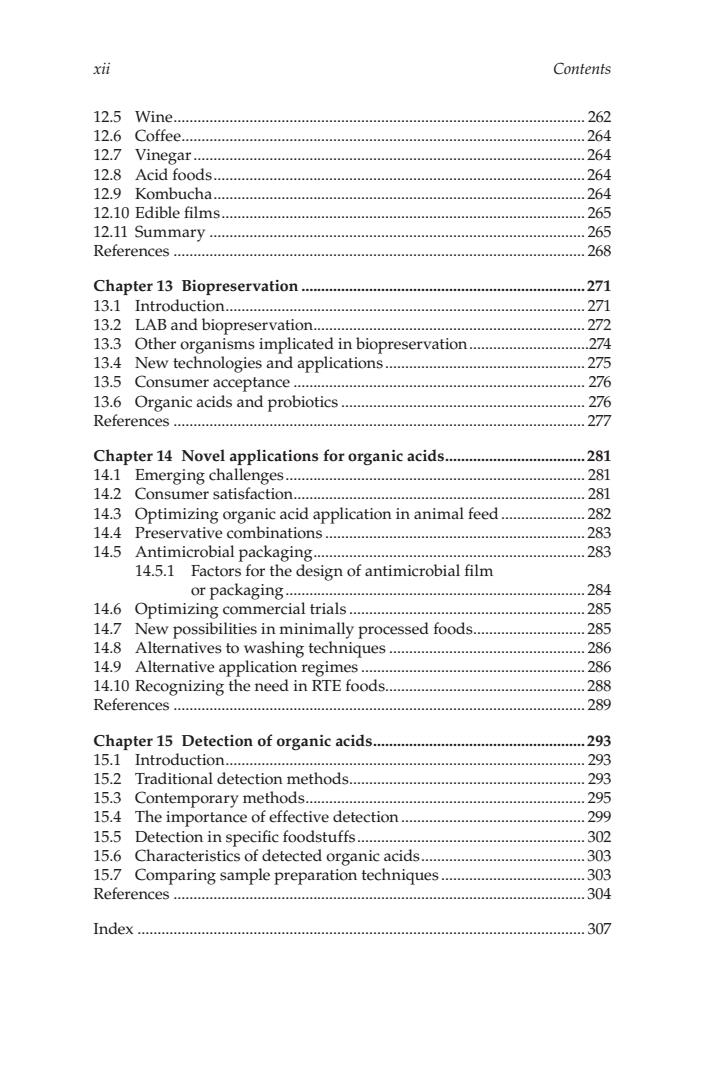
xii Contents 125 Wine 26 Coffee. 26 gar. 264 .264 buc . .264 12.10 Edible films .265 12.11 Summarv. 265 References.... .268 Chapter 13 Biopreservation... 271 13.1 Introduction.. 271 13.2 LAb and biopreservation. 22 13.3 Other organisms implicated in biopreservation.........................74 13.4 New technologies and applications. .273 13.5 Consumer acceptance. 276 13.6 Organic acids and probiotics. 276 References .277 Chapter 14 Novel applications for organic acids .281 14.1 Emerging challenges. 281 14.2 Consumer satisfaction.. .281 14.3 Optimizing organic acid application in animal feed 282 5只2 14.5 A 14.51 design of antimicrobial filn or pac kaging. 2 14.6 Optimizing cmmercial trials 285 1 285 14.8 New possibilities in minimally processed foods Alternatives to washing techniques... 286 14.9 Alternative application regimes 286 14.10 Recognizing the need in RTE foods.. 288 References 289 Chapter 15 Detection of organic acids 293 15.1 Introduction..... .....293 15.2 Traditional detection methods. 293 15.3 Contemporary methods.. 295 15.4 The importance of effective detection. 290 15.5 Detection in specific foodstuffs.. 200 156 Characteristic of detected organic acids 202 15.7 Comparing sample preparatic n techniques 202 Reference 304 Index 307
xii Contents 12.5 Wine....................................................................................................... 262 12.6 Coffee..................................................................................................... 264 12.7 Vinegar.................................................................................................. 264 12.8 Acid foods............................................................................................. 264 12.9 Kombucha............................................................................................. 264 12.10 Edible films........................................................................................... 265 12.11 Summary .............................................................................................. 265 References ....................................................................................................... 268 Chapter 13 Biopreservation ....................................................................... 271 13.1 Introduction.......................................................................................... 271 13.2 LAB and biopreservation.................................................................... 272 13.3 Other organisms implicated in biopreservation..............................274 13.4 New technologies and applications .................................................. 275 13.5 Consumer acceptance ......................................................................... 276 13.6 Organic acids and probiotics ............................................................. 276 References ....................................................................................................... 277 Chapter Novel applications for organic acids 14 ...................................281 14.1 Emerging challenges........................................................................... 281 14.2 Consumer satisfaction......................................................................... 281 14.3 Optimizing organic acid application in animal feed..................... 282 14.4 Preservative combinations ................................................................. 283 14.5 Antimicrobial packaging.................................................................... 283 14.5.1 Factors for the design of antimicrobial film or packaging........................................................................... 284 14.6 Optimizing commercial trials ........................................................... 285 14.7 New possibilities in minimally processed foods............................ 285 14.8 Alternatives to washing techniques ................................................. 286 14.9 Alternative application regimes ........................................................ 286 14.10 Recognizing the need in RTE foods.................................................. 288 References ....................................................................................................... 289 Chapter Detection of organic acids 15 ..................................................... 293 15.1 Introduction.......................................................................................... 293 15.2 Traditional detection methods........................................................... 293 15.3 Contemporary methods...................................................................... 295 15.4 The importance of effective detection .............................................. 299 15.5 Detection in specific foodstuffs......................................................... 302 15.6 Characteristics of detected organic acids......................................... 303 15.7 Comparing sample preparation techniques .................................... 303 References ....................................................................................................... 304 Index ................................................................................................................ 307